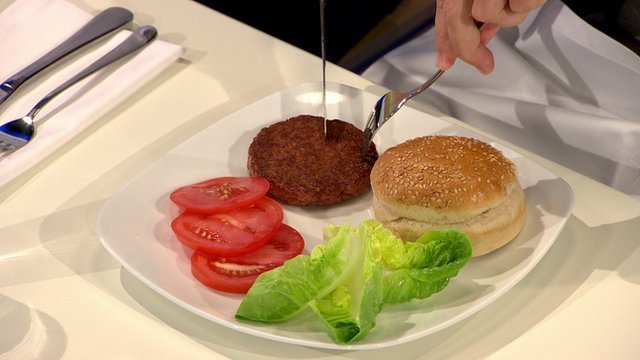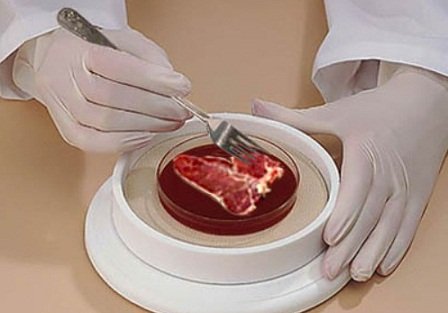Frankenburger, the world’s first lab-grown burger, was cooked and eaten at a news conference in London today.
Dutch scientists took cells from a cow and turned them into strips of muscle that they combined to make a patty.
Researchers say the technology could be a sustainable way of meeting what they say is a growing demand for meat.
Critics say that eating less meat would be an easier way to tackle predicted food shortages.
The burger was cooked by chef Richard McGowan, from Cornwall, and tasted by food critics Hanni Ruetzler and Josh Schonwald.
Upon tasting the burger, Austrian food researcher Hanni Ruetzler said: “I was expecting the texture to be more soft… there is quite some intense taste; it’s close to meat, but it’s not that juicy. The consistency is perfect, but I miss salt and pepper.”
She added: “This is meat to me. It’s not falling apart.”
Food writer Josh Schonwald said: “The mouthfeel is like meat. I miss the fat, there’s a leanness to it, but the general bite feels like a hamburger.
“What was consistently different was flavor.”
Prof Mark Post, of Maastricht University, the scientist behind the burger, remarked: “It’s a very good start.”
He said the meat was made up of tens of billions of lab-grown cells. Asked when lab-grown burgers would reach the market, he said: “I think it will take a while. This is just to show we can do it.”
Sergey Brin, co-founder of Google, has been revealed as the project’s mystery backer.

The world’s first lab-grown burger was cooked and eaten at a news conference in London
Prof. Tara Garnett, head of the Food Policy Research Network at Oxford University, said decision-makers needed to look beyond technological solutions.
“We have a situation where 1.4 billion people in the world are overweight and obese, and at the same time one billion people worldwide go to bed hungry,” she said.
“That’s just weird and unacceptable. The solutions don’t just lie with producing more food but changing the systems of supply and access and affordability, so not just more food but better food gets to the people who need it.”
Stem cells are the body’s “master cells”, the templates from which specialized tissue such as nerve or skin cells develop.
Most institutes working in this area are trying to grow human tissue for transplantation to replace worn-out or diseased muscle, nerve cells or cartilage.
Prof. Mark Post is using similar techniques to grow muscle and fat for food.
He starts with stem cells extracted from cow muscle tissue. In the laboratory, these are cultured with nutrients and growth-promoting chemicals to help them develop and multiply. Three weeks later, there are more than a million stem cells, which are put into smaller dishes where they coalesce into small strips of muscle about a centimetre long and a few millimetres thick.
These strips are collected into small pellets, which are frozen. When there are enough, they are defrosted and compacted into a patty just before being cooked.
Because the meat is initially white in color, Helen Breewood – who works with Prof. Mark Post – is trying to make the lab-grown muscle look red by adding the naturally-occurring compound myoglobin.
“If it doesn’t look like normal meat, if it doesn’t taste like normal meat, it’s not… going to be a viable replacement,” she said.
She added: “A lot of people consider lab-grown meat repulsive at first. But if they consider what goes into producing normal meat in a slaughterhouse, I think they would also find that repulsive.”
Currently, this is a work in progress. The burger revealed today was colored red with beetroot juice. The researchers have also added breadcrumbs, caramel and saffron, which were intended to add to the taste, although Hanni Ruetzler said she could not taste these.
At the moment, scientists can only make small pieces of meat; larger ones would require artificial circulatory systems to distribute nutrients and oxygen.
[youtube 1HgstR1K5OQ]
Frankenburger, the world’s first lab-grown burger, is to be unveiled and eaten at a news conference in London on Monday.
Scientists took cells from a cow and, at an institute in the Netherlands, turned them into strips of muscle which they combined to make a patty.
Researchers say the technology could be a sustainable way of meeting what they say is a growing demand for meat.
Critics say that eating less meat would be an easier way to tackle predicted food shortages.
Professor Mark Post of Maastricht University, the scientist behind the burger, said: “Later today we are going to present the world’s first hamburger made in a lab from cells. We are doing that because livestock production is not good for the environment, it is not going to meet demand for the world and it is not good for animals.”
But Prof. Tara Garnett, head of the Food Policy Research Network at Oxford University, said decision-makers needed to look beyond technological solutions.
“We have a situation where 1.4 billion people in the world are overweight and obese, and at the same time one billion people worldwide go to bed hungry,” she said.
“That’s just weird and unacceptable. The solutions don’t just lie with producing more food but changing the systems of supply and access and affordability so not just more food but better food gets to the people who need it.”
Stem cells are the body’s “master cells”, the templates from which specialized tissue, such as nerve or skin cells develop.

Frankenburger, the world’s first lab-grown burger, is to be unveiled and eaten at a news conference in London
Most institutes working in this area are trying to grow human tissue for transplantation, to replace worn out or diseased muscle, nerve cells or cartilage.
Mark Post wants to use similar techniques to grow muscle and fat for food.
He starts with stem cells extracted from cow muscle tissue. In the laboratory, these are cultured with nutrients and growth promoting chemicals to help them develop and multiply. Three weeks later, there are more than a million stem cells which are put into smaller dishes where they coalesce into small strips of muscle about a centimetre long and a few millimetres thick.
These strips are collected into small pellets which are frozen. When there are enough, they are defrosted and compacted into a patty just before being cooked.
The scientists have tried to make the meat – which is initially white in color – as authentic as possible. Helen Breewood, who is working with Prof. Mark Post, makes the lab-grown muscle look red by adding the naturally occurring compound myoglobin.
Currently, this is a work in progress. The burger to be revealed on Monday will be colored red with beetroot juice. The researchers have also added breadcrumbs, caramel and saffron, which will add to the taste.
At the moment, scientists can only make small pieces of meat; larger ones would require artificial circulatory systems to distribute nutrients and oxygen.
Prof. Mark Post said initial sampling suggests the burger will not taste great, but he expected it to be “good enough”.
Helen Breewood is a vegetarian because she believes meat production to be waste of resources, but says she would eat lab-grown meat.
“A lot of people consider lab-grown meat repulsive at first. But if they consider what goes into producing normal meat in a slaughter house I think they would also find that repulsive,” she said.
In a statement, animal welfare campaigners People for the Ethical Treatment of Animals (PETA) said: “[Lab-grown meat] will spell the end of lorries full of cows and chickens, abattoirs and factory farming. It will reduce carbon emissions, conserve water and make the food supply safer.”
The latest United Nations Food and Agriculture Organization report on the future of agriculture indicates that most of the predicted growth in demand for meat from China and Brazil has already happened and many Indians are wedded to their largely vegetarian diets for cultural and culinary reasons.
Lab grown meat might turn out to be a technological solution in search of a problem.
[youtube 27PO_nu3BEs]
[youtube VikkBQRtbdk]
A new research shows that drinking five or more cups of tea a day lowers the risk of advanced prostate cancer by a third.
Men who drink five or more cups daily have a 33% lower risk of developing stage IV prostate cancer, scientists found.
They also have a 25% reduced risk of reaching stage II, compared with those who drink just one cup a day.

Drinking five or more cups of tea a day lowers the risk of advanced prostate cancer by a third
Stage II is where the tumor has grown inside the prostate gland but not spread. By stage IV the cancer has typically spread to the lymph nodes, bones or liver.
It is believed naturally occurring compounds in tea called flavonoids inhibit cancer cells from forming tumors.
The good news is that it doesn’t matter if you have milk, sugar, sweetener or lemon in your tea. The health benefits are not reduced.
Scientists in the Netherlands analyzed data on 58,279 men and found 3,362 cases of prostate cancer, including 1,164 advanced cancers.
By finding out how much tea the men drank and what foods they ate, they were able to compare their lack of flavonoid intake with their health record.
Dr. Milan Geybels, lead researcher at Maastricht University, said: “We had data on tumour stage for most cases which made it possible to stratify data against the stage of the disease.
“Our study included a large number of advanced stage prostate cancers.”
One cup of tea provides about 150-200mg of flavonoids.



